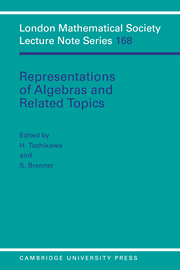Book contents
- Frontmatter
- Contents
- Introduction
- Homologically finite subcategories
- Global generatedness version of rings of pure global dimension zero
- Projective resolutions and degree shifting
- Modules of finite length over their endomorphism rings
- Pairs of semi-simple algebras (hereditary algebras with radical-square zero)
- The module theoretical approach to quasi-hereditary algebras
- Matrix problems, small reduction and representations of a class of mixed Lie groups
- Classification problems for modular group representations
- Lie algebras (arising in representation theory)
Global generatedness version of rings of pure global dimension zero
Published online by Cambridge University Press: 05 August 2013
- Frontmatter
- Contents
- Introduction
- Homologically finite subcategories
- Global generatedness version of rings of pure global dimension zero
- Projective resolutions and degree shifting
- Modules of finite length over their endomorphism rings
- Pairs of semi-simple algebras (hereditary algebras with radical-square zero)
- The module theoretical approach to quasi-hereditary algebras
- Matrix problems, small reduction and representations of a class of mixed Lie groups
- Classification problems for modular group representations
- Lie algebras (arising in representation theory)
Summary
INTRODUCTION
In connection with Auslander's theory [2] on rings of finite representation type, the equivalence of the following three conditions for a ring R was established by Zimmermann [15] and Gruson-Jensen [9]: (1) every left R–module is a direct sum of finitely generated submodules, (2) every indecomposable left R–module is finitely presented, (3) for any left R–module M, every pure submodule of M is a direct summand of M. Now, as is easily seen, in terms of pure-projectivity and pure-injectivity the condition (3) can be described either as (4) every left R–module is pure-projective or as (5) every left R–module is pure-injective. Because of this R is called a ring of left pure global dimension zero if it satisfies any of these equivalent conditions. The purpose of the present paper is to show that even if we restrict ourselves to countably generated modules in each of the conditions between (2) and (5) we have equivalent conditions, that is, each of the following conditions characterizes R to be a ring of left pure global dimension zero: (2′) every countably generated indecomposable left R–module is finitely presented, (3′) for any countable generated left R–module M, every countably generated pure submodule of M is a direct summand of M, (4′) every countably generated left R–module is pure-projective, (5′) every countably generated left R–module is pure-injective.
- Type
- Chapter
- Information
- Representations of Algebras and Related Topics , pp. 43 - 79Publisher: Cambridge University PressPrint publication year: 1992
- 4
- Cited by



